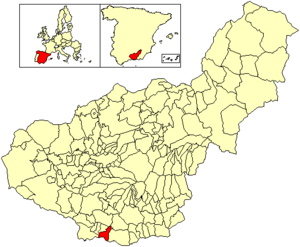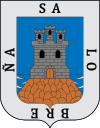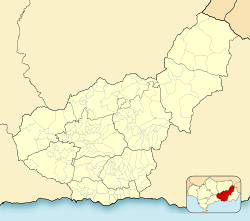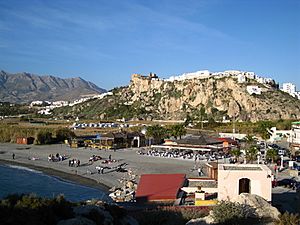Salobreña facts for kids
Quick facts for kids
Salobreña
|
|||
|---|---|---|---|

|
|||
|
|||

Location of Salobreña
|
|||
| Country | |||
| Autonomous community | |||
| Province | Granada | ||
| Comarca | Costa Tropical | ||
| Judicial district | Motril | ||
| Area | |||
| • Total | 34.91 km2 (13.48 sq mi) | ||
| Elevation | 95 m (312 ft) | ||
| Highest elevation | 160 m (520 ft) | ||
| Lowest elevation | 0 m (0 ft) | ||
| Population
(2018)
|
|||
| • Total | 12,396 | ||
| • Density | 355.08/km2 (919.66/sq mi) | ||
| Demonym(s) | Salobreñero, -ra | ||
| Time zone | UTC+1 (CET) | ||
| • Summer (DST) | UTC+2 (CEST) | ||
| Postal code |
18680 (Salobreña y
La Caleta-Guardia), 18610 (Lobres) |
||
| Official language(s) | Spanish | ||
Salobreña is a beautiful town on the Costa Tropical (Tropical Coast) in Granada, Spain. People believe its history goes back an amazing 6,000 years!
Salobreña has two main parts. The first is the Old Town. It sits high up on a rocky hill. This part of town is full of white houses and narrow, steep streets. These streets lead up to a very old Moorish castle from the tenth century. This castle, called 'Castillo de Salobreña', is one of the town's most popular places to visit.
The second part of Salobreña is made up of newer buildings. These spread out from the bottom of the Old Town all the way to the beach. The town is almost surrounded by fields of sugarcane along the coast and further inland.
Another cool place to see in Salobreña is 'El Peñón' (The Rock). This large rock sticks out into the sea. It divides two of Salobreña's five beaches. You can find it between Playa La Guardia and Playa de la Charca/Solamar.
Contents
Salobreña's Long History
Salobreña has a very long and interesting past. People have lived here for thousands of years.
How the Land Was Formed
Long ago, after the last Ice Age, the area where Salobreña is now was mostly water. It was a big bay with rocky islands. The Guadalfeo river flowed into this bay. Over time, the river brought a lot of mud and sand. This material slowly filled the bay. It created a rich, flat land perfect for farming.
By the Bronze Age, the rocky hill where the Old Town stands became a peninsula. This means it was connected to the land on one side. The rock called El Peñón, which is now on the beach, was actually an island until the 1700s!
Life in Ancient Salobreña
Archaeologists have found signs that people lived around Salobreña as early as the Neolithic period (New Stone Age). This was when El Peñón was still an island. They also found evidence from the Bronze Age (around 1500 BCE) on the Salobreña hill. These early settlements were often on rocky hills. This made them easy to defend.
Salobreña likely had contact with the Phoenicians around 800 BCE. Later, it was influenced by Greek and Punic cultures. Its name back then was Selambina. The Roman Empire had a big impact on the area around 200 BCE. Many Roman artifacts have been found.
Medieval Times and Moorish Rule
In 713 CE, the area came under Arab rule. By the tenth century, a castle was built in Salobreña. This castle is mentioned in old writings. It was also around this time that sugar cane farming started in Salobreña. Sugar cane became the main crop during the Middle Ages. Other crops like cumin and bananas were also grown.
By the eleventh century, Salobreña was known as a medina, which means a town. It became an important center for nearby villages. In 1489, the region came under Spanish rule. More Spanish people moved into the town. Later, in 1568-69, some local people called Moriscos took part in revolts.
Modern Salobreña and Sugarcane
Sugar cane remained very important to Salobreña's economy for a long time. It became very popular again in the 1800s. During the Spanish War of Independence in the 1800s, Salobreña was an important strategic location. New steam technology from Cuba was used for sugar production.
As the town grew in the late 1800s, its old medieval walls were taken down. By the 1970s, the town started to spread from the old hill onto the flat land below.
Today, the economy around Salobreña relies on tourism and farming. The mountains nearby grow almonds and tropical fruits like custard apples and avocado pears. The very last sugar cane factory in Europe was near Salobreña. It closed in 2006.
Weather in Salobreña
Salobreña has a warm, Mediterranean climate. It doesn't get a lot of rain, about 500mm (20 inches) per year. It has a special microclimate that is subtropical. This means it's great for growing tropical plants.
In the hotter months, like August, the average temperature is around 26 °C (79 °F). It can reach the mid-30s °C (mid-90s °F) during the day. At night, it stays around the mid-20s °C (mid-70s °F). In the colder months, the average is about 13 °C (55 °F). The average temperature for the whole year is 19 °C (66 °F).
See also
 In Spanish: Salobreña para niños
In Spanish: Salobreña para niños







